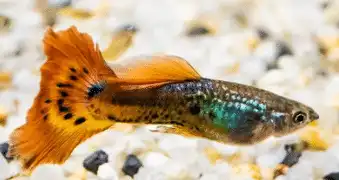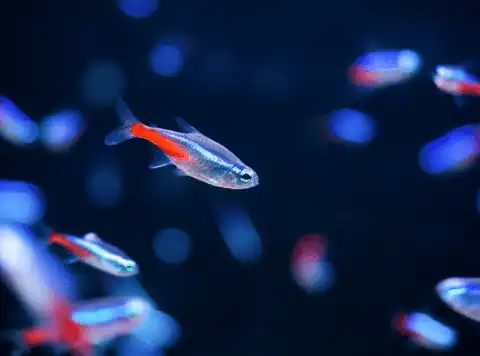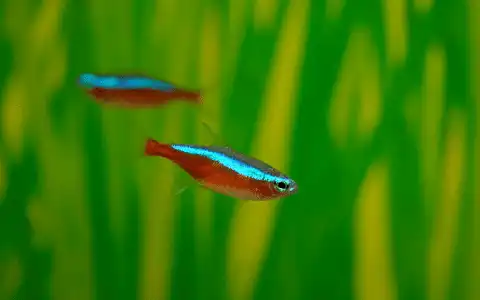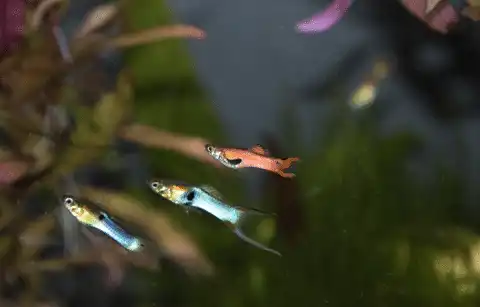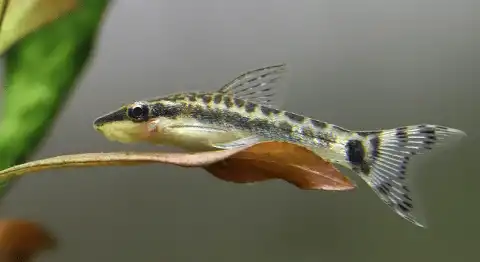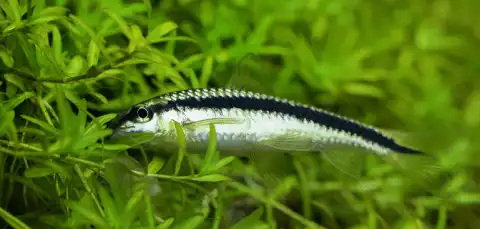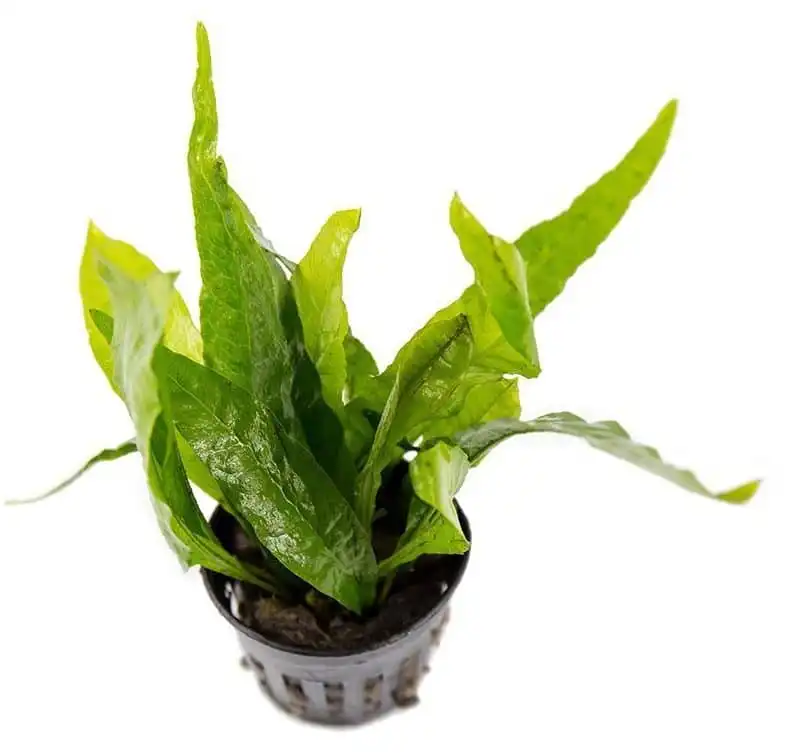Thank you for visiting! By the way… any links on this page that lead to products on Amazon and other stores/partners are affiliate links Aquarium Store Depot earns a commission if you make a purchase.
Do you keep molly fish? Congratulations, you have some wonderful pets! But did you know that molly fish can be kept with many other great freshwater fish? Choosing the perfect tank mates always requires great care, but this article will make your decision so much easier!
Read along to learn about the 15 best tank mates for molly fish. Let’s get started!
Key Takeaways
- Choose peaceful, similar-sized fish when choosing tank mates for your molly fish.
- Be careful not to overstock your aquarium by adding too many fish. 30 gallons is a good starting size for a great molly fish community tank.
- Make sure all the fish you want to keep will be happy in the same conditions and parameters.
Choosing Molly Fish Tank Mates – What You Need To Know
Choosing the best tank mates for molly fish is all about understanding their needs and the other species you want to add to their tank. We’ll be covering some amazing fish species later in this post, but let’s start by going over the thought process for choosing great tank mates.
Temperament
Some fish are more aggressive than others, so it’s important to choose fish with similar levels of aggression.
Molly fish are peaceful but not shy. They can hold their own with fairly boisterous fish but should not be kept with aggressive fish or larger predatory species.
Mollies are livebearers. They will eat their own young, but so will most other tank mates, so it is best to set up a breeding tank if you plan on breeding molly fish (video source).
Mollies are generally peaceful, but they will often eat shrimp. You could try to keep them together in a heavily planted tank with loads of hiding spaces, however.
Size
There is a general rule in the fish-keeping hobby. If a fish can fit in another fish’s mouth, they are not safe tank mates!
Mollies grow from 4-6 inches long and are certainly capable of eating very small, slow-moving fish. Likewise, large fish can easily snack on your mollies. Choose similar-sized fish, although fast schooling fish like neon tetras are generally safe.
Competition
Molly fish are hardy and have a very healthy appetite. They are not likely to be outcompeted for food at meal times, but you might need to make sure other shy species are getting their fair share.
Parameters & Tank Setup
It is vitally important to compare the preferred water parameters of different fish before adding them together in a community fish tank. Some fish have very specific needs and just won’t survive in typical tropical fish tanks.
Let’s take a look at the recommended water parameters for your molly fish:
- pH: 7 – 8.5
- Water Temperature: 68 – 82°F
- Minimum Tank Size: 15 gallons (29 gallons+ recommended)
- Water Flow: Low-Moderate
Molly fish can live in saltwater, but most other fish aren’t so flexible, so never mix fresh and saltwater fish in the same tank.
15 Greatv Aquarium Mates
Having considered all the information above, it’s time to dive in and meet 15 awesome freshwater fish that you can keep with mollies.
Let’s get started!
1. Dwarf Gourami

- Scientific Name: Trichogaster lalius
- Origin: Bangladesh, India, Pakistan
- Minimum tank size: 15 gallons
- Care Level: Intermediate
- Swimming Level: All levels
- Adult Size: 2 inches
- Water Temperature: 72 – 82 °F
- pH: 6 – 8
- Diet: Omnivore
The dwarf gourami is a peaceful community fish with an interesting look. A pair of these colorful labyrinth fish would make a great addition to your molly fish community tank.
Dwarf gouramis are relatives of the betta fish. They come in some amazing colors, including neon reds, blues, and orange tones. They are fairly shy and will do best in a planted aquarium.
2. Guppy
An undemanding fish that is a livebearer. Many varieties available
- Scientific Name: Poecilia reticulata
- Origin: Northeast South America
- Minimum tank size: 10 gallons
- Care Level: Easy
- Swimming Level: All levels
- Adult Size: 1.75 inches
- Water Temperature: 64 – 82°F
- pH: 5.5 – 8
- Diet: Omnivore
Guppies are ideal tankmates for your molly fish. Guppy fish are basically, the smaller, more colorful cousin of the molly fish. They are very easy to care for and will add loads of life to your tropical fish tank.
Guppy fish are livebearers, just like mollies. They will breed regularly in your aquarium, although the fry are not likely to survive the hungry mouths of their larger tank mates.
3. Platy
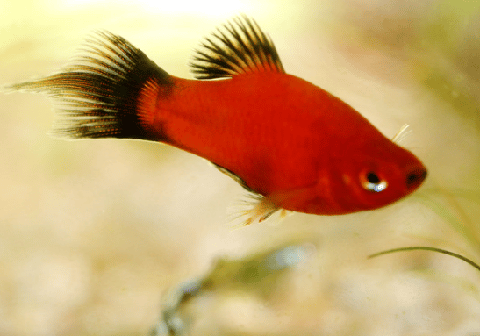
- Scientific Name: Xiphophorus maculatus
- Origin: Mexico & Central America
- Minimum tank size: 10 gallons
- Care Level: Easy
- Swimming Level: All levels
- Adult Size: 2 inches
- Water Temperature: 64 – 77 °F
- pH: 7 – 8.2
- Diet: Omnivore
Platy fish are another small livebearer that are peaceful tank mates for mollies. There are many different platy breeds, often with bold shades of yellow, orange, and black. These undemanding fish are a great choice for a mixed livebearer tank.
4. Neon Tetra
Use Promo Code ASDFLIPPROMO
One of the most popular freshwater community schooling fish available in the aquarium trade. Great neon blue colors!
- Scientific Name: Paracheirodon innesi
- Origin: South America
- Minimum tank size: 10 gallons
- Care Level: Easy
- Swimming Level: Middle
- Adult Size: 1.25 inches
- Water Temperature: 68 – 78 °F
- pH: 5 – 7
- Diet: Omnivore
Neon tetras add a burst of bright color and activity to any freshwater tropical aquarium. These small schooling fish are peaceful and very easy to care for.
Neon tetras prefer a lower pH than mollies, so they are not recommended for tanks with a pH over 7. These tiny tetras are strictly schooling fish, so make sure you pick up a group of at least 6 to 10.
5. Cardinal Tetra
A very popular schooling fish. Looks like the Neon Tetra, but with longer blue and red stripes. Grows larger than a neon tetra as well
- Scientific Name: Paracheirodon axelrodi
- Origin: South America
- Minimum tank size: 10 gallons
- Care Level: Intermediate
- Swimming Level: Middle
- Adult Size: 2 inches
- Water Temperature: 73 – 81 °F
- pH: 5.5 – 7.5
- Diet: Omnivore
The Cardinal tetra is another brightly colored tetra species from South America. They are a slightly larger and even more colorful relative of the neon tetra. These peaceful fish are a little more challenging to care for, and also come with a higher price tag.
Cardinal Tetras reward the fishkeeper with amazing colors and a peaceful attitude. They make a wonderful tank mate for molly fish.
6. Endler’s Livebearers
A very active and colorful livebearer. Smaller in size than guppies
- Scientific Name: Poecilia wingei
- Origin: Venezuela
- Minimum tank size: 10 gallons
- Care Level: Easy
- Swimming Level: All levels
- Adult Size: 1 inch
- Water Temperature: 75 – 86 °F
- pH: 7 – 8.5
- Diet: Omnivore
Endler’s livebearer fish are very similar to guppies, but do not grow as large and have different markings and fins. Endler’s livebearer fish are very confident, even though they are small fish. These peaceful nano fish make some of the best tank mates for mollies.
7. Otocinclus Catfish
A small algae-eating fish. Also great with freshwater shrimp.
- Scientific Name: Otocinclus spp.
- Origin: South America
- Minimum tank size: 10 gallons
- Care Level: Intermediate
- Swimming Level: Bottom & Glass
- Adult Size: 2 inches
- Water Temperature: 74 – 79 °F
- pH: 6 – 7.5
- Diet: Algae
Otos are nano catfish that do a very important job in the aquarium. They are super-peaceful, and one of the only fish that will not eat your molly fry.
These tiny fish eat algae on the glass and other surfaces in your aquarium to keep the tank looking neat and clean.
8. Zebra Danio
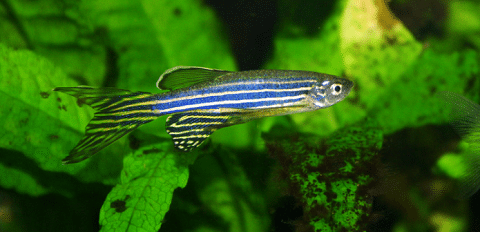
- Scientific Name: Brachydanio rerio
- Origin: India
- Minimum tank size: 20 gallons
- Care Level: Easy
- Swimming Level: All levels
- Adult Size: 2 gallons
- Water Temperature: 64 – 75 °F
- pH: 6.5 – 7.5
- Diet: Omnivore
Zebra danios are very fast and hardy tropical freshwater fish. These active community fish are great for adding heaps of movement to any community tank.
Zebra danios are peaceful fish that will thrive on the same food and care as their live-bearing tank mates.
9. Siamese Algae Eater
A great algae-eating fish that is known for eating black beard algae. Grows up to 7 inches in length and requires a larger aquarium
- Scientific Name: Crossocheilus siamensis
- Origin: Southeast Asia
- Minimum tank size: 30 gallons
- Care Level: Intermediate
- Swimming Level: Bottom
- Adult Size: 6 inches
- Water Temperature: 75 – 79 °F
- pH: 6.5 – 7
- Diet: Omnivore
The Siamese algae eater is another excellent molly fish tank mate. Choose this peaceful fish species for keeping your tank clean and adding activity. Fish keepers also appreciate their ability to devour black beard algae (BBA) – something that very few aquarium fish will eat!
Siamese algae eaters are very fast, active fish that will also enjoy prepared fish food like flakes and pellets. They grow up to 6 inches and they should be kept in school of at least 4 so keep them in a tank of 30 gallons or more.
10. Cory Catfish
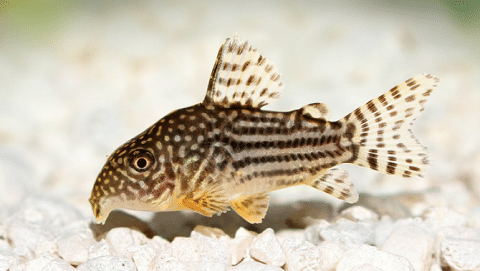
- Scientific Name: Corydoras spp.
- Origin: South America
- Minimum tank size: 10 – 30 gallons depending on fish species
- Care Level: Easy
- Swimming Level: Bottom
- Adult Size: 1 – 3 inches
- Water Temperature: 74 – 80 °F
- pH: 7 – 8
- Diet: Omnivore
The corydoras catfish is a great addition to any peaceful community tank. These small bottom dwellers are super peaceful and will not bother your molly fish at all. Cory cats are very social fish, so you’ll need a school of at least 6 of the same species to see them acting at their confident best.
Cory catfish come in tonnes of different species, ranging from the tiny midwater schoolers like the dwarf cory to the regular-sized species like bronze, Sterba’s, and panda cories.
11. White Cloud Mountain Minnow
A very peaceful fish that does well in coldwater fish. Other minnow varieties are also available
- Scientific Name: Tanichthys albonubes
- Origin: China
- Minimum tank size: 10 gallons
- Care Level: Easy
- Swimming Level: Upper/Middle
- Adult Size: 1.5 inches
- Water Temperature: 64 – 72 °F
- pH: 6- 8
- Diet: Omnivore
White cloud mountain minnows are excellent community fish for cooler water conditions. These graceful schooling fish tend to hang out in middle to upper layers of the water column.
White clouds are easy to care for and come in a cool long-finned variety as well as a gold color morph. They will not make good tank mates with tropical fish but they will be happy at 68 – 72 degrees which is the lower limit for your molly fish.
12. Harlequin Rasboras
A peaceful schooling fish. An ideal community fish. A great beginner fish
- Scientific Name: Rasbora heteromorpha
- Origin: Southeast Asia
- Minimum tank size: 10 gallons
- Care Level: Easy
- Swimming Level: Upper/Middle
- Adult Size: 1.5 inches
- Water Temperature: 72 – 77 °F
- pH: 6 – 7.5
- Diet: Omnivore
Harlequin rasboras are hardy schooling fish that make a great addition to a molly fish community tank. These colorful fish have a rich orange body color with a bold black triangular marking on each side.
They enjoy similar water parameters to molly fish but will do best towards the lower end of the pH and water temperature range. Add a school of 8 or more to enjoy their beautiful schooling behavior.
13. Bristle Nose Pleco
The Bristlenose Pleco is a smaller Pleco that does a great job of eating algae. Peaceful and gets along with most fish
- Scientific Name: Ancistrus sp.
- Origin: South America
- Minimum tank size: 30 gallons
- Care Level: Easy
- Swimming Level: Bottom
- Adult Size: 6 inches
- Water Temperature: 72 – 82 °F
- pH: 6.5 – 7
- Diet: Omnivore
Are you looking for a unique bottom dweller to add to your molly fish tank? Look no further than the weird and wonderful bristle nose pleco! These small armored catfish spend their time hanging out at the bottom of the tank.
They graze on algae and driftwood, and won’t bother your mollies, although you should only keep one pleco in the tank to avoid any fighting. Just make sure you pick up a bristle nose pleco rather than a larger species.
14. Swordtails

- Scientific Name: Xiphophorus hellerii
- Origin: Mexico & Central America
- Minimum tank size: 20 gallons
- Care Level: Easy
- Swimming Level: Middle/upper
- Adult Size: 4 inches
- Water Temperature: 64 -82 °F
- pH: 7 – 8.3
- Diet: Omnivore
The swordtail is yet another great livebearer for freshwater tanks. They are extremely peaceful and come in an exciting array of different colors and breeds. Swordtails are a little smaller than mollies and the males have a long, distinctive tail which is where they get their name.
These hardy fish are very easy to care for and won’t interbreed with your mollies. Swordtails enjoy very similar water parameters too, so you won’t need to worry about the two being comfortable in the same tank.
15. Tiger Barbs
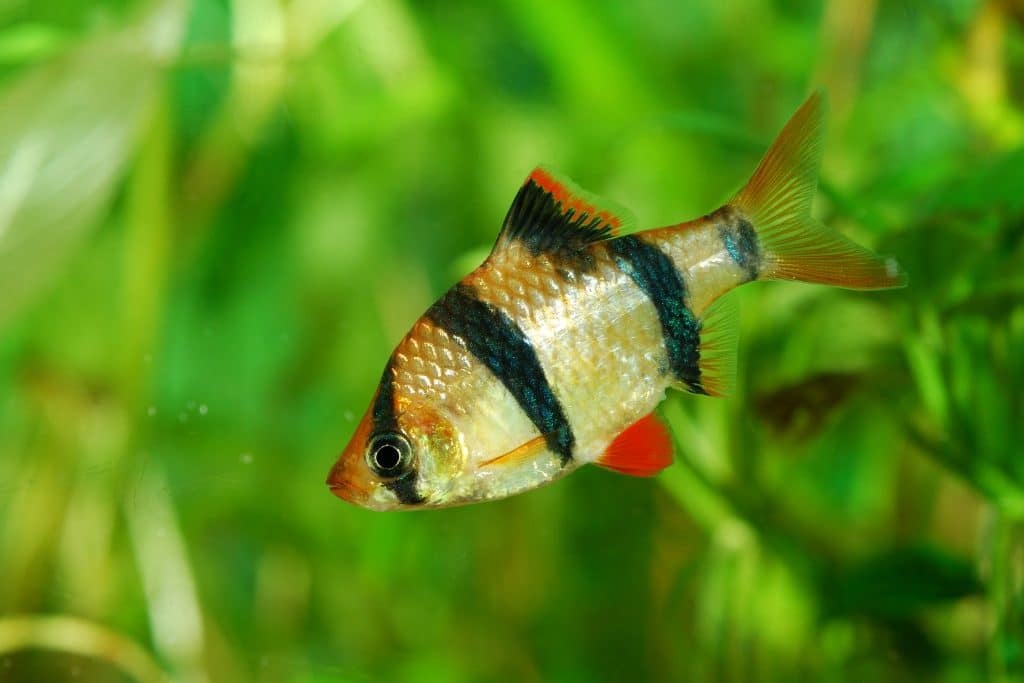
- Scientific Name: Puntius tetrazona
- Origin: Southeast Asia
- Minimum tank size: 30 gallons
- Care Level: Easy
- Swimming Level: Middle
- Adult Size: 3 inches
- Water Temperature: 74 – 79 °F
- pH: 6 – 7
- Diet: Omnivore
Tiger barbs have a reputation for being a little mean towards other fish, but fortunately, mollies are tough and hardy, so they can handle themselves just fine. However, make sure to keep your tiger barbs in a school of at least 6 (preferably more) to prevent any aggression.
Community Aquarium Setup
Are you ready to set up your own molly fish community tank? Let’s take a look at what you will need!
Aquarium Size
Molly fish are often kept in tanks as small as 15 gallons, although I would recommend starting at 30 gallons for a small community setup. A 55-gallon tank would be a better option if you want to have a few different fish species in schools.
Heating
Molly fish require a heater in most homes. If you live in a warm area, you might be able to keep molly fish in an unheated aquarium with other fish species like white cloud minnows, swordtails, and zebra danios.
A reliable heater is a safer bet because it allows you to maintain a healthy, stable temperature for your fish. An electric thermometer with an alarm that sounds when the water gets too cool is very useful as a reminder if you’re going to be switching off your heater for the summer.
Filtration
Good filtration is the difference between a healthy vibrant tank and a toxic environment. Invest in good filtration if you want the best for the fish in your molly community tank.
A large sponge filter (or two) is a doable option for your molly community tank, but a hang-on back or canister filter is going to provide much better mechanical filtration in larger aquariums.
The Best Aquarium Power Filter
The worlds best selling and most reliable power filter on the market. Unchanged for years because it's so reliable and versatile
Don’t be afraid to run two different filters in your community tank. Overfiltering is a great way to keep your water quality high, although you should take care to keep your water flow down to low or moderate levels.
Decorations and Substrate
Adding decorations and substrate is a great way to make your molly community tank a more interesting environment for your fish, and a more appealing display for you and your family.
You can let your creativity run wild when arranging your layout, or take a more natural approach to recreate the wild environment of your fish.
Whichever route you take, make sure you use fish-safe products that are designed for aquarium use. You can design a beautiful layout by using a combination of the following materials:
- Substrate: Sand, gravel, or aquarium soil
- Driftwood: Spiderwood, manzanita, etc.
- Rocks: Dragon stone, seiryu, lava rock, etc.
- Ornaments/decorations: Caves, sunken ships, castles, etc.
Live plants
Live plants make the difference between a good aquarium and a great aquarium. They might not be for everyone, but aquarium plants can be remarkably easy to care for and provide some amazing benefits for your fish.
Start with the following species if you’re new to growing live plants:
- Java Fern – A low-maintenance epiphyte
- Amazon Sword – A large-leaved rosette plant
- Water Wisteria – A fast-growing stem plant
Java Fern is one of the easiest and hardiest live plants you can purchase
Feeding your fish
Molly fish are very easy to feed, like most of the recommended tank mates in this post. They will thrive on a diet of high-quality prepared foods like flakes or pellets. Feed your fish once or twice a day, providing only enough food for them to finish in a minute or two.
Supplement your fish’s diet with occasional treats like frozen foods, baby brine shrimp, blood worms, and other insect larvae. It will improve their condition, and they’ll love it too!
Some fish have specialized diets, and the otocinclus catfish mentioned in this article is a good example.
These tiny catfish only eat algae, so they need to be kept in a mature, healthy aquarium with a good supply of natural algae. They can also be fed with vegetables like zucchini and other algae foods like wafers.
Where To Buy Aquarium Mates
All the fish in this list of tank mates for molly fish were selected to be easy to care for and easy to locate. You should have no trouble finding them at most pet stores, but consider buying from some of my recommended online dealers for a hassle-free online shopping experience! Flip Aquatics gets my full recommendation as they quarantine all their livestock.
Use Promo Code ASDFLIPPROMO
Founded in 2010. Robert and his team at Flip Aquatics have set the standard for conditioned freshwater fish. One of the best selections of freshwater shrimp and nano fish on the internet
FAQs
What Fish Can Mollies Live With?
Mollies can live with a variety of other fish species. Popular compatible fish include other livebearers and small schooling fish like tetras and corydoras catfish.
Do Mollies Need Aquarim Mates?
Mollies do not need tank mates, although they are a great community fish species. However, you should not keep just a single molly because these fish prefer to live in groups with their own species.
How Many Mollies Should Be Kept Together?
It is best to keep a minimum of 3 mollies, although you can keep a much larger school if you have a large aquarium. Keep one male molly fish and two or three female molly fish in a smaller tank.
Do Mollies Eat Other Fish?
Mollies do not usually eat other fish although they will eat anything slow enough and small enough to swallow. They will feed on baby fish fry.
Can Black Mollies Live With Other Companions?
Black molly fish make great community fish. They can be kept with the same tank mates as other molly breeds like sailfin molly fish and balloon molly fish.
Are Mollies Bottom-Dwelling?
Molly fish usually hang out in the middle layers of the aquarium. However, they will explore and forage in all layers of your fish tank.
Final Thoughts
Molly fish are one of the most popular species in the aquarium hobby for a good reason. These fascinating and hardy pets get along great with many other fish species. Pick tank mates from this list for your own community aquarium and enjoy everything these fish have to offer!
Do you keep molly fish in a community tank? Tell us about your favorite tank mates in the comments below!
- About the Author
- Latest Posts
I’m thrilled that you found Aquarium Store Depot! Here you’ll find information on fish, aquariums, and all things aquatics related. I’m a hobbyist (being doing this since I was 11) and here to help other hobbyists thrive with their aquariums! I adhere to a high quality Editorial Process and Review products with real life field usage and practical analysis.


